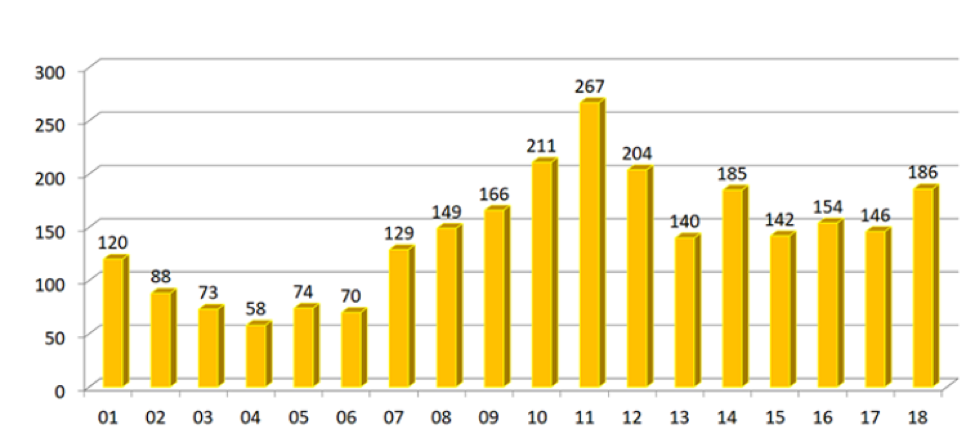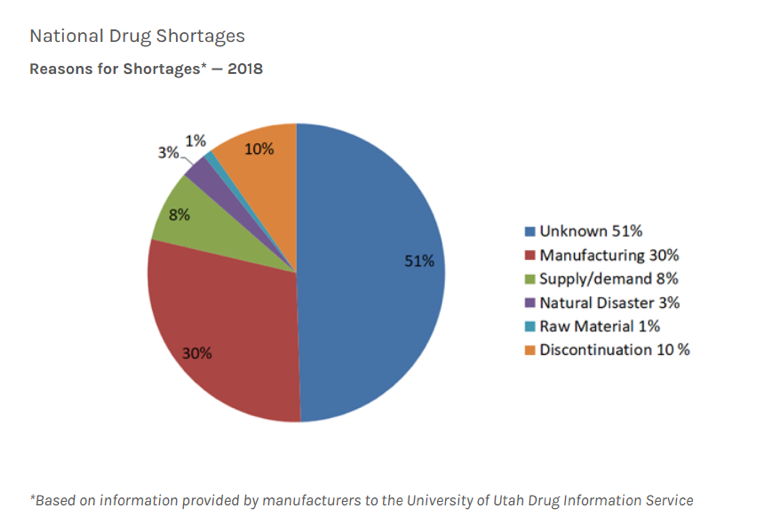Article
Drug Shortages: Contributing Factors, Mitigating the Impact
Author(s):
The impact has been a continual struggle for pharmacies to provide adequate and appropriate patient care.
Drug shortages in 2018 and extending into 2019 have meant a continual struggle for pharmacies to provide adequate and appropriate patient care.
National drug shortage data show, however, that 2018 was not unique. Since 2007, drug shortages have totaled more than 100 per year. The Drug Information Service at University of Utah Health Care has tracked the total number of drug shortages per year, with the data showing 2011 as the largest total in history with 267 drug shortages (Figure 1).
Figure 1. National Drug Shortages: Annual by Year

Data are from the University of Utah Drug Information Service (2019) and ASHP Drug Shortages Statistics (2019).
Several causative factors have contributed to recent shortages. Hurricane Maria in 2017 in Puerto Rico affected 5 of the world’s 10 top drug manufacturers and 11 of the top 20 products in the world.1 Although the devastation has helped put in place measures to prevent this impact again, the shortage of fluids and required allocations has just recently been lifted for many manufacturers.
Restrictions on injectable opioids by the Drug Enforcement Administration (DEA) have also been affecting patient care, including anesthesia. This includes fentanyl, hydromorphone, and morphine injections. Although the DEA did raise the production quotas allowed for manufacturers in mid-2018, the shortage continued with recall notices and production issues from manufacturers.2
Additional shortages have resulted from manufacturers ceasing production of a generic drug, even temporarily, and the inability of other manufacturers to generate additional volumes. Raw material issues can also pose issues for supply. Figure 2 identifies some of the reasons for shortages, though “unknown” continues to be the largest contribution.
Figure 2. Reasons for Drug Shortages

Data are from the University of Utah Drug Information Service (2019) and ASHP Drug Shortages Statistics (2019).
This means several things for patients. The first is the inability to get the drug needed or insufficient quantity, resulting in either sub-therapeutic dosing or the need to find an alternative. Pharmacists and providers are spending significant amounts of time researching alternatives to drug therapy. This does not include the impact to pharmacy databases and informaticists, who must continually modify the pharmacy formulary based on the National Drug Code and package size that are available. Finally, drug shortages increase the chance of errors, because of a change in concentration, the need for compounding unavailable doses, or the use of multiple dose vials.
An Institute for Safe Medication Practices survey showed that nearly a quarter of all pharmacist and pharmacy worker respondents (21%) were aware of at least 1 medication error related to a drug shortage.3
In addition to the impact on patients, the financial burden on hospitals continues to rise. To maintain an adequate supply of inventory, pharmacies must purchase greater quantities than needed, increasing both the cost of drugs as well as the chance for outdated inventory. The time for drug shortage management for buyers is also an increased cost, as well as the increased time spent for pharmacists reviewing alternatives and shortage strategies.
To help mitigate issues causing the shortages and lessen the impact, the FDA created the Agency Drug Shortages Task Force. This committee is tasked with investigating the root causes of shortages and promoting long-term resolutions to Congress.4 Some of the effects from this task force include expediting inspections for manufacturers to increase production in shortages and investigating root causes to prevent future shortages.
Kristy Malacos, CPhT, is the pharmacy administrator and purchasing director at Magruder Hospital in Port Clinton, Ohio.
References
- Jarvis LM. Hurricane Maria's lessons for the drug industry. Chemical & Engineering News. September 17, 2018. cen.acs.org/pharmaceuticals/biologics/Hurricane-Marias-lessons-drug-industry/96/i37. Accessed March 21, 2019.
- Kacik A. DEA lifts production quotas to ease injectable opioid shortage. Modern Healthcare. April 14, 2018. modernhealthcare.com/article/20180414/NEWS/180419944/dea-lifts-production-quotas-to-ease-injectable-opioid-shortage. Accessed March 21, 2019.
- FDA. Agency drug shortages task force. fda.gov/Drugs/DrugSafety/DrugShortages/ucm620590.htm. Updated November 20, 2018. Accessed March 21, 2019.





